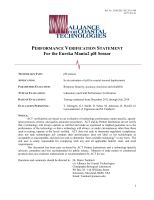

Ref. No. [UMCES] CBL 2015-009
ACT VS15-02
5
BACKGROUND AND OBJECTIVES
Instrument performance verification is necessary so that effective existing technologies
can be recognized and so that promising new technologies can be made available to support
coastal science, resource management and ocean observing systems. To this end, the NOAA-
funded Alliance for Coastal Technologies (ACT) serves as an unbiased, third party testbed for
evaluating sensors and sensor platforms for use in coastal environments. ACT also serves as a
comprehensive data and information clearinghouse on coastal technologies and a forum for
capacity building through workshops on specific technology topics (visit
www.act-us.info).
As part of our service to the coastal community, ACT conducted a performance
verification of commercially available, in situ pH sensors through the evaluation of objective and
quality assured data. The goal of ACT’s evaluation program is to provide technology users with
an independent and credible assessment of instrument performance in a variety of environments
and applications. Therefore, the data and information on performance characteristics was
focused on the types of information that users most need.
The fundamental objectives of this Performance Verification were to: (1) highlight the
potential capabilities of particular in situ pH sensors by demonstrating their utility in a range of
coastal environments; (2) verify the claims of manufacturers on the performance characteristics
of commercially available pH sensors when tested in a controlled laboratory setting, and (3)
verify performance characteristics of commercially available pH sensors when applied in real
world applications in a diverse range of coastal environments.
In 2012 ACT completed a customer needs and use assessment on pH sensors. Scientists,
resource managers, and other users of these technologies were asked about their current use or
application of these instruments, their perceptions of limitations or problems with the
technology, and the most important criteria they use when selecting a sensor or instrument
package. The results of these assessments, conclusions from the 2005 Measurement of
Dissolved Inorganic Carbon Speciation in Natural Waters workshop, and discussions with the
Technical Advisory Committee were used to identify the main applications and key parameters
that ACT evaluates in this Technology Verification.
Over 170 coastal resource managers, environmental health agency representatives,
manufacturers, and scientific researchers were surveyed regarding their needs, uses and current
practices of making pH measurements in the environment. Overall, 42 individuals responded to
the survey, all of which are using, or manufacturing, in situ pH sensors. Respondents were
allowed to select more than one answer when appropriate so percentages do not add up to 100%.
The types of pH sensors being used varied between potentiometric (45%), ion-selective field-
effect transistor (32%), and spectrophotometric (using indicator dye) 20%, but with a quarter of
respondents using more than one type. The greatest area of use among respondents was
academic research (76%) followed by state and federal resource management (40%). The
environmental applications were broad with coastal ocean greatest (74%), followed by estuarine
(64%), followed by open-ocean (41%), and followed by freshwater (38%). Correspondingly,
these environments included temperature ranges from -5 to 50
o
C, with medians of 5
o
C and
28
o
C when responses were binned into low and high ranges. Similarly, salinities ranged from
0 – 100, with low and high bin medians of 15 and 35, respectively. The range of pH measured
by the respondents in these applications was between 4.0 and 11.0, with low and high bin median
values of 7.0 and 8.3. Remote deployment was the most common method of use (74%),

















